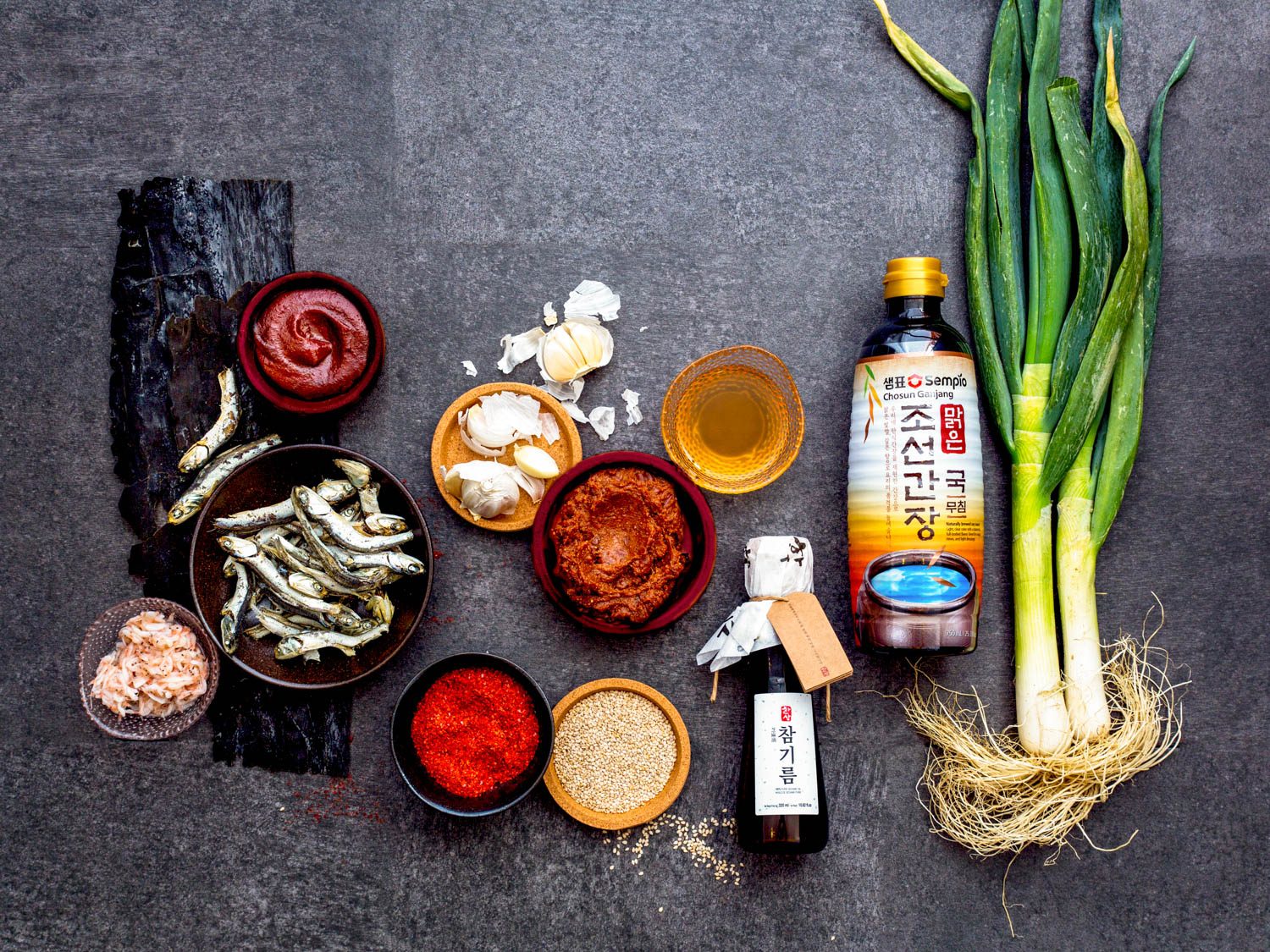
[Photographs: Michelle Min]
Korean food always seems to be on the verge of having its moment in the press. It seems like every couple of years, some publication somewhere will identify it as the next up-and-coming cuisine, even though Maangchi is a household name and bottles of probiotic kimchi “gut shots” stand on supermarket shelves alongside Guy Fieri’s Korean BBQ Wing Sauce. At my local K-town grocery store, I sometimes see more non-Koreans than Koreans, and a whole lot of people in the United States appear to already know that there’s more to Korean cuisine than just kimchi and barbecue. But eating Korean food is one thing, and knowing how to stock your pantry to cook it is another.
I grew up in a Korean-American household, and our dinner table frequently featured rice and banchan, those small, savory side dishes, like pickles, blanched bean sprouts, and sautéed anchovies. Kimchi was always a side with our Thanksgiving turkey. But it wasn’t until I took a cooking class with Seoyoung Jung in Seoul that I started to reassess what I knew about Korean cuisine and reflect on the fundamentals of Korean ingredients.
Jung has worked to broaden the world’s conception of Korean cuisine ever since she started cooking professionally in the US. Her background is in classic French cuisine—she studied at The Culinary Institute of America and went on to work in the kitchens of Eleven Madison Park, Gordon Ramsay at The London, and Oceana—but she moved back to Seoul in 2011 and started working as a research and development chef in the Korean fermented-foods industry. In her free time, Jung earned a certification from the Institute of Korean Royal Cuisine, where recipes and techniques used to prepare food in the royal kitchens of the Joseon Dynasty are preserved and passed on.
After we met, she invited me to join her on a yearlong blog project, traveling around the countryside to farms and fishing villages, to explore the country’s full range of seasonal ingredients. One year turned into three years, and I learned that even though Korean cuisine varies by region—for example, it tends to be spicier and saltier in the warmer southern areas, since capsaicin and salt function as natural preservatives—nearly all Korean kitchens have a set of core ingredients in common. Naturally, to compile this list of essential pantry items, I sought out Jung’s expertise.
One of the first points she emphasizes: “Chilies and garlic are important, but I really wish people knew that not all Korean food is spicy!” There’s a lot more to Korean cuisine: earthy bean-paste soups, mild rice porridges, icy buckwheat noodles, lightly seasoned vegetable banchan, and an abundance of savory dumplings with no chili pepper heat at all. “There are even white kimchis made without chili powder,” Jung says. She also points to often-overlooked Korean culinary traditions like royal cuisine, which is rarely spicy because heat masks the natural flavors of the high-quality ingredients brought to the royal kitchens, and temple food, which eschews spices and alliums because they are said to excite the senses and distract from spiritual contemplation.
Another thing to keep in mind is that the Korean pantry is a living one. “Fermentation is essential to Korean cooking,” Jung says. With Korea’s hot, humid summers and freezing-cold winters, preserved foods naturally became a cornerstone of the cuisine. Though kimchi is probably Korea’s most famous fermented product, fermented soy and fermented seafood are just as important.
So without further ado, here’s everything you’ll need to dive into Korean cooking.
The Three Essential Jang
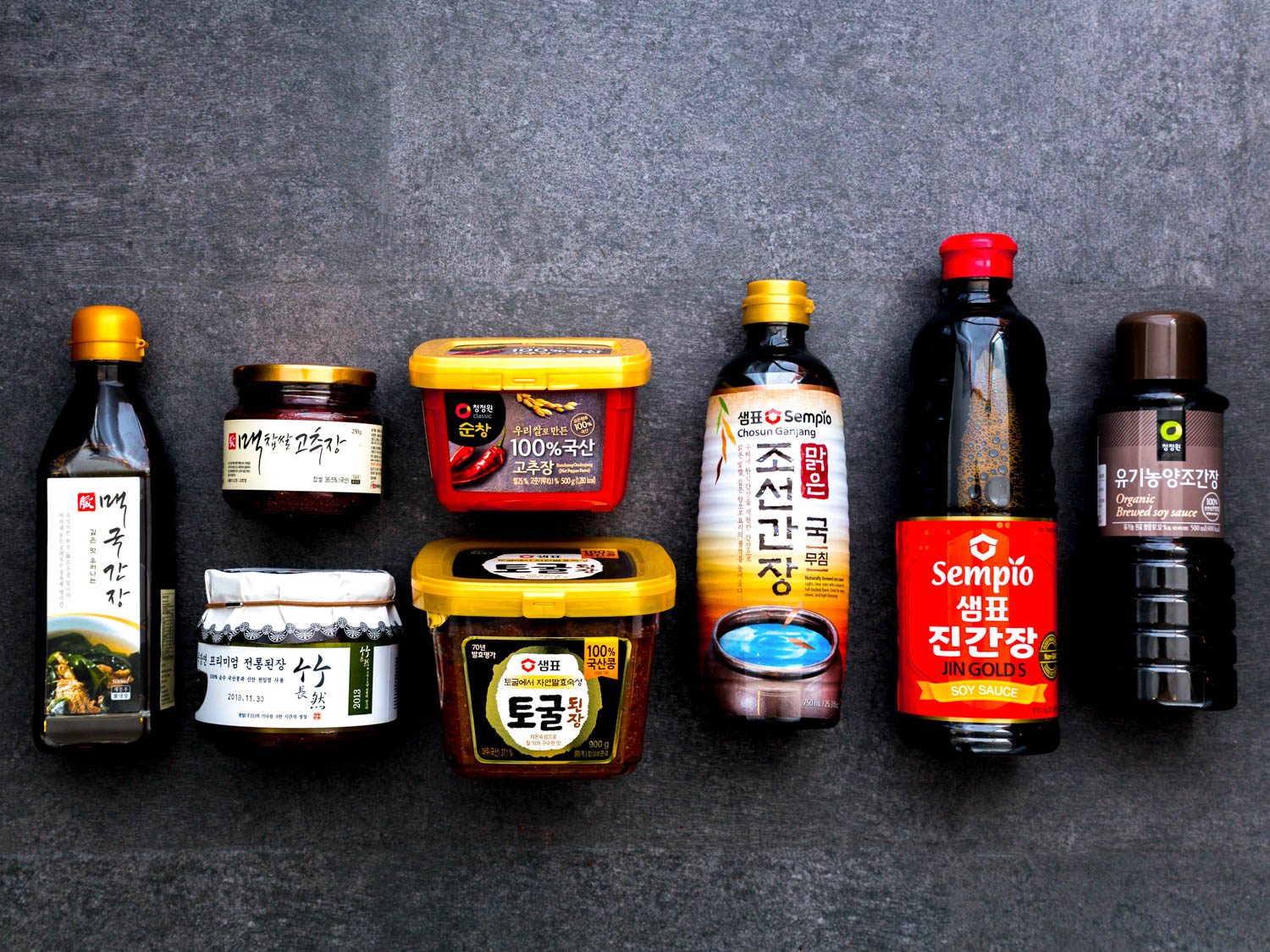
From left to right: Mac artisanal ganjang, Mac sweet rice gochujang and Chung Jung One sunchang gochujang (top row), Jookjangyeon artisanal doenjang and Sempio togul doenjang (bottom row), Sempio Joseon ganjang, Sempio jin ganjang, Chung Jung One organic yangjo ganjang.
“To understand Korean cuisine, you have to understand jang,” says Jung. “Koreans use jang to season almost everything!” Jang are sauces made from fermented soy blocks, or meju, which are pressed from boiled soybeans and inoculated with wild molds like Aspergillus oryzae or the bacteria Bacillus subtilis (or both) using rice straw. There are many kinds of jang, but you’ll find three in every Korean kitchen: ganjang (soy sauce), doenjang (soybean paste), and gochujang (chili paste). Traditionally, ganjang and doenjang were made together in one earthenware jar at the beginning of winter—Jung calls them “twins from one mother.” The meju are soaked in brine and release flavorful amino acids as the mold and bacteria break down the soy proteins over the cold winter months. When the solids are strained out, they’re fermented separately as doenjang, while the dark and flavorful brine ferments to become ganjang. Gochujang is made in a separate process by mixing crushed meju powder with a grain porridge, rice syrup, salt, and chili powder.
Ganjang
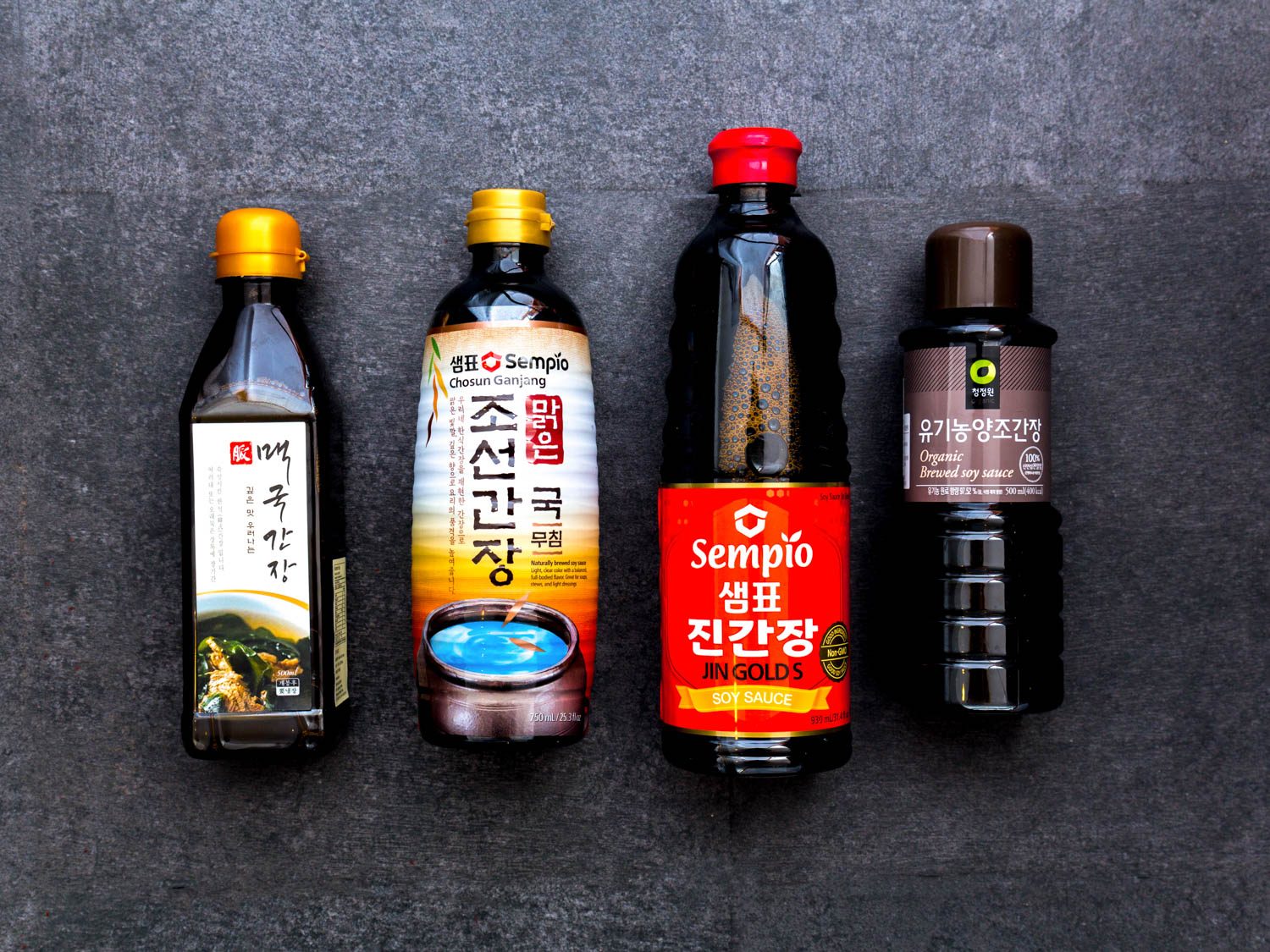
Most large Korean grocery stores carry a dizzying array of soy sauces, but to simplify things, Jung suggests looking for three basic varieties: Joseon ganjang, yangjo ganjang, and jin ganjang. Joseon ganjang (also called guk-ganjang, or soup soy sauce), is made with just soybeans, salt, and water and typically ferments for about a year. Its flavor tends to be more assertive than the other ganjang, with more funky, meaty notes, especially in artisanal products. Jung likes using Joseon ganjang anywhere soy sauce is required as a seasoning—soups, banchan, et cetera. She suggests using it to season food a little at a time while you get used to its flavor profile. Sempio’s Joseon ganjang is a mild, easy-to-find brew, and Mac makes a Joseon ganjang that you’ll find in larger Korean markets. Yangjo ganjang is made in the same way as Joseon ganjang and ferments for about six months, but the fermented mixture also includes wheat, a holdover from Japanese colonization. “The wheat makes yangjo ganjang sweeter, so keep that in mind when cooking,” Jung advises. Yangjo ganjang is good for meat marinades and dipping sauces, and makes an acceptable substitute for Joseon ganjang if you’re not a fan of the latter’s stronger flavors. Look for Chung Jung One’s organic yangjo ganjang. Finally, jin ganjang is a sauce made with soy proteins that are quickly and thoroughly broken down with chemical enzymes, resulting in an ultra-savory, one-note seasoning—pretty much equivalent to your garden-variety bottom-shelf soy sauce. “The name ‘jin ganjang’ used to refer to soy sauce that was aged for three to five years, but today it’s used for this cheap, mass-produced product,” Jung explains. “Still, if you’re cooking in bulk, like making soy pickles, jin ganjang can be useful.”
Doenjang
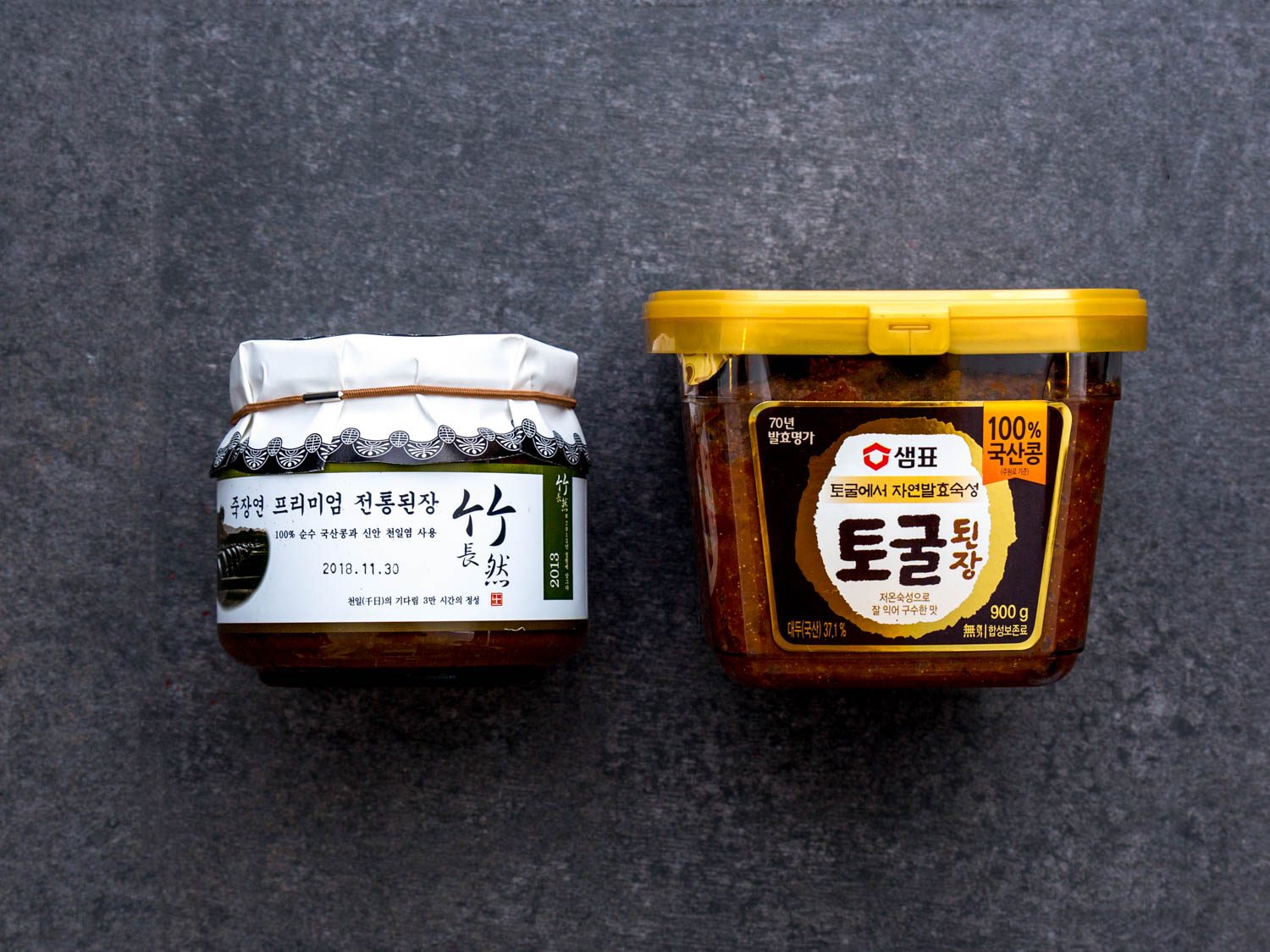
Like other fermented soybean pastes, doenjang is savory and full of umami. It tends to be darker and funkier than miso, but it doesn’t have quite the pungency of black bean paste. Doenjang traditionally ages for two years, though industrial processes are much shorter—and just as with ganjang, some doenjang is now made with wheat, resulting in a sweeter product, so Jung advises looking at ingredient labels before buying. These days, she says, most Korean young people have grown up with and prefer the sweeter doenjang. It’s more difficult to find doenjang without wheat in the US, but if you can get your hands on some, give it a try for a deeper, more rustic flavor profile. Jung likes Sempio’s togul doenjang, a naturally fermented product that uses non-GMO beans and is aged in a cave. Jookjangyeon, an artisanal producer that ages its jang in earthenware jars, has recently started exporting its products to the US, and you can find its doenjang at some large Korean grocery stores.
Doenjang can be used in marinades and dipping sauces, and is a very common stew and soup base. “It goes really well with aged cheese!” Jung says. It’s also a key ingredient in ssamjang, a dipping sauce for barbecue and lettuce wraps. Jung’s recipe for ssamjang calls for mixing one part doenjang and one part gochujang (“or more, if you want it spicier”) with crushed roasted sesame seeds, minced garlic, and a little sesame oil. Doenjang is similar in some ways to miso, though, if you plan to substitute it in recipes that call for miso, keep in mind that it is funkier and much saltier, and adjust accordingly.
Gochujang
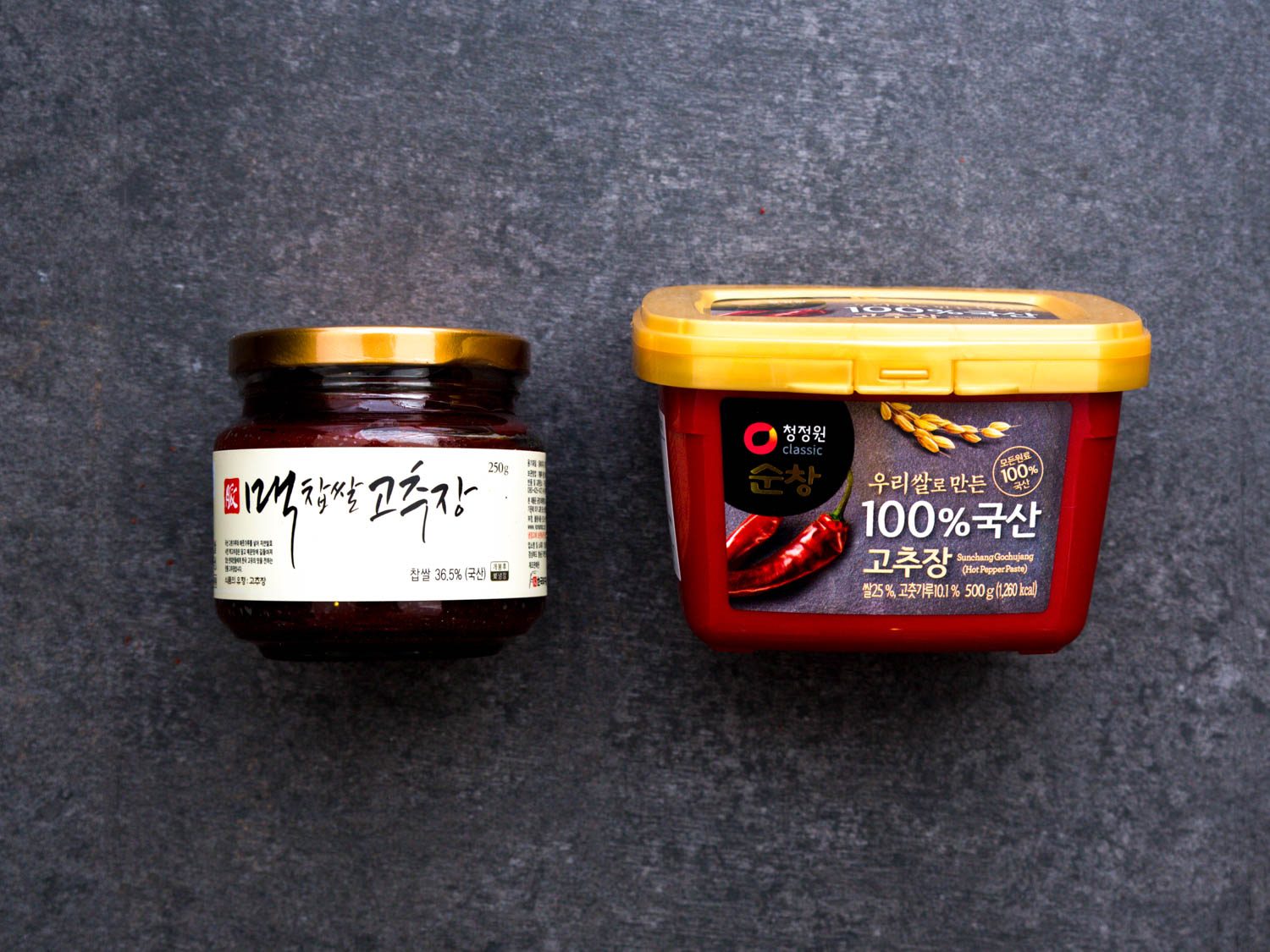
Gochujang is a relative newcomer in Korea, as chilies weren’t widely used on the peninsula until the 1600s. It’s made from a usually rice-based grain porridge, gochugaru (more on this below), meju powder, and salt, and carries a natural sweetness from the fermenting grains. This sweetness, along with its addictive, fruity fire, has made gochujang one of Korea’s most popular fermented exports. Jung cautions against buying gochujang that contains corn syrup, which is more intensely sweet than the jocheong, or rice syrup, that’s traditionally used; you can always add more sweetness later if you need it. Chung Jung One’s sunchang gochujang is made with Korean rice syrup and no additives, and you can find Mac’s sweet rice gochujang, a small-batch product, in some large Korean grocery stores. Gochujang is great for marinades, dipping sauces, and seasoning banchan. Try a generous dab with some sesame oil on your bibimbap, or mix it with vinegar for sashimi.
The Gajeun Yangnyeom (“Everything Seasonings”)
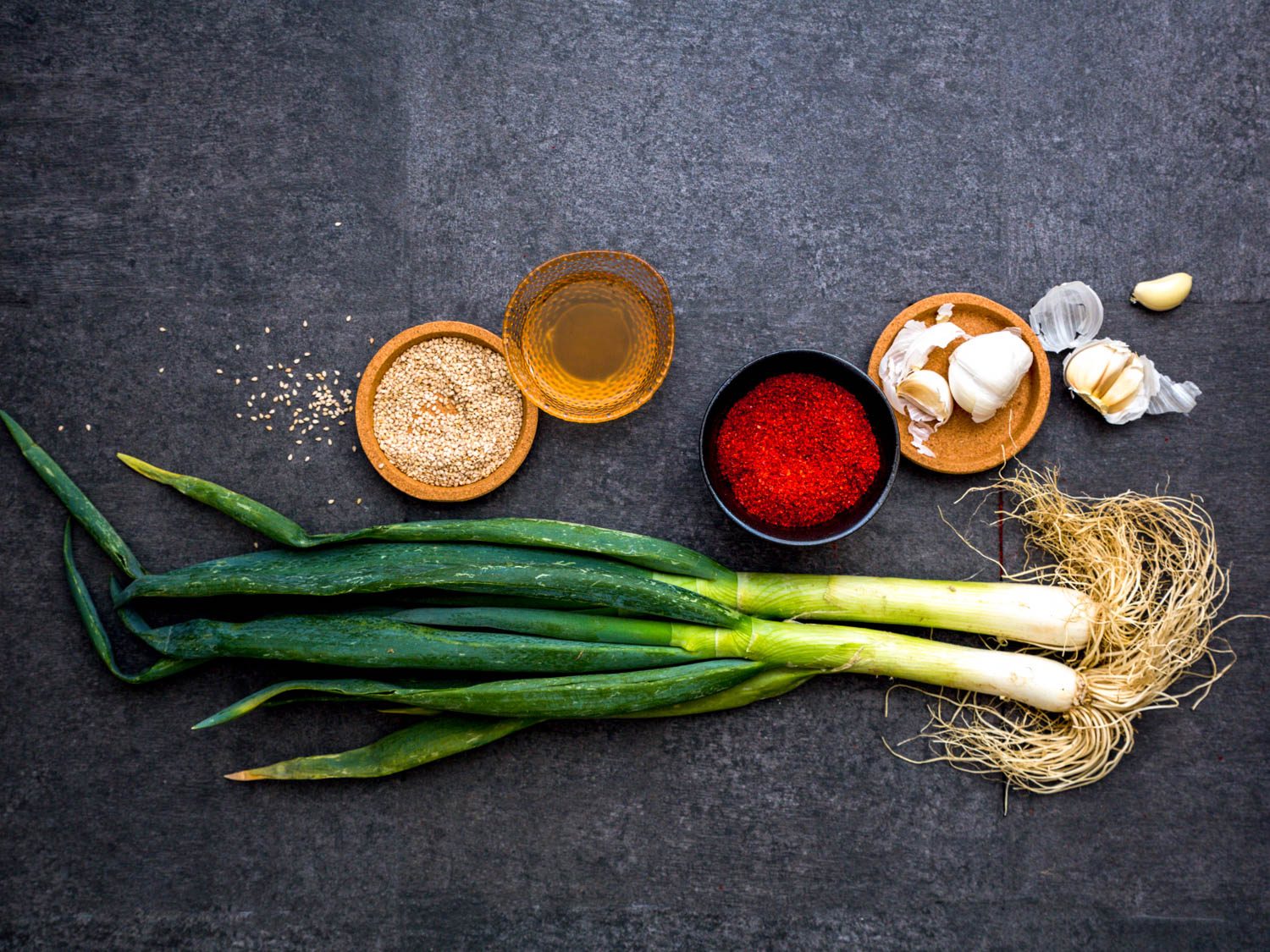
“Every Korean mom has their own blend of seasonings they put into their gajeun yangnyeom,” says Jung. This “everything seasoning” is one of those essential, ambiguous ingredients used to flavor banchan or marinades: A typical Korean-mom recipe, Jung explains, will tell you to season your banchan (especially blanched vegetables) as you go along using your gajeun yangnyeom, which includes something salty, like jang, and, often but not always, something sweet, like sugar or plum syrup. The baseline version is a mix of jang, gochugaru, crushed garlic, minced daepa (Welsh onion), and crushed toasted sesame seeds.
Gochugaru
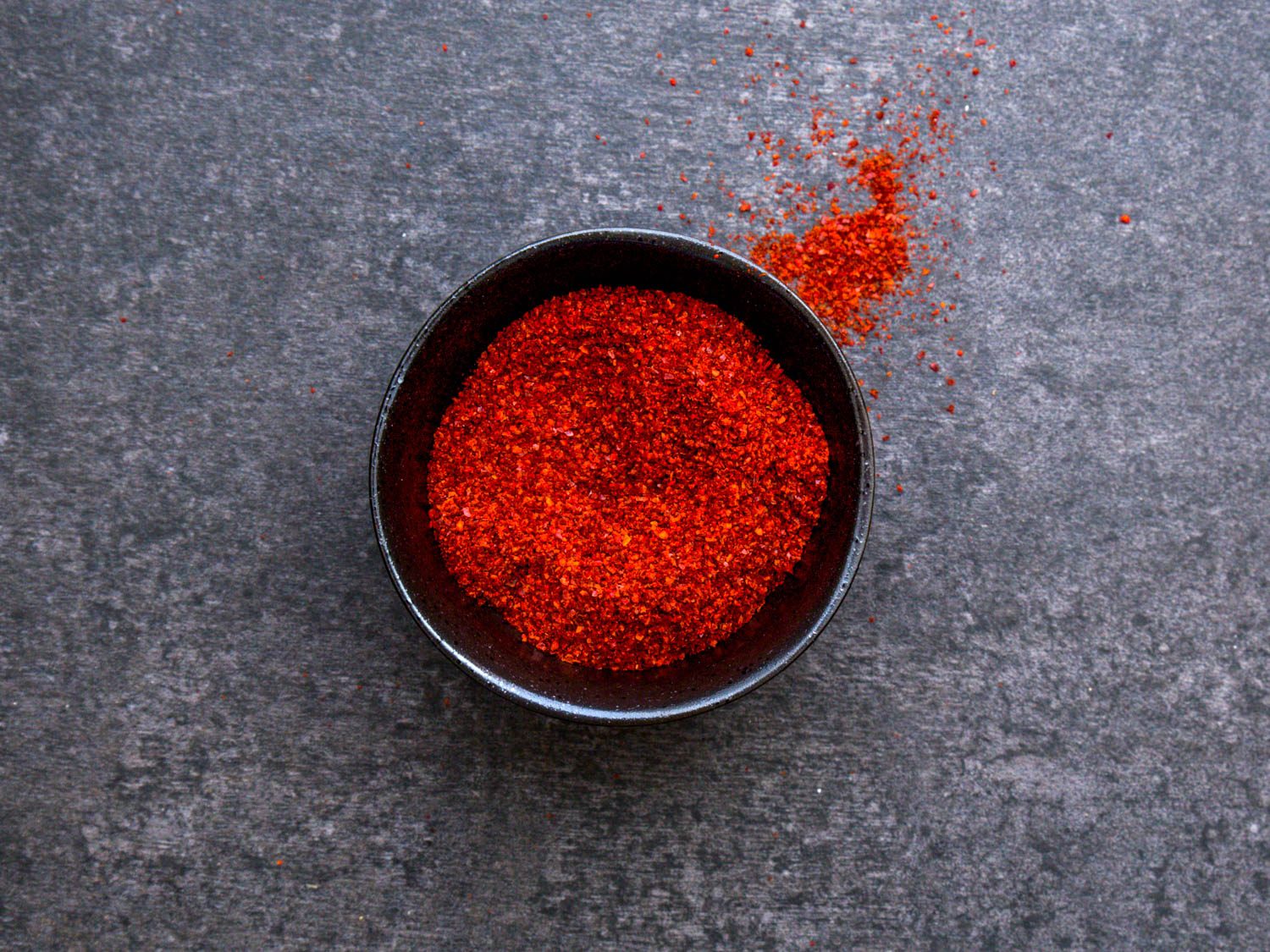
Gochugaru, or chili powder, has a different flavor profile from the chili powder you typically find on Western supermarket shelves. “It’s not sharp and fiery, but it has more of a continuous, long-lasting heat with more fruity tones,” Jung says. One exception is cheongyang gochugaru, a variety that kicks up the heat several notches (and is fairly hard to find in the US). In general, you’ll encounter two different grinds of gochugaru: The coarse grind is the general go-to product—in coffee terms, it’s close to a coarse, French-press grind. Goun gochugaru, more akin to an espresso grind, is a finer powder used for making gochujang and coloring the brine in water kimchi.
Koreans are picky about their chili powder—many will grow and sun-dry their own chilies in the early fall, then bring them to the local mill for grinding, or buy dried chilies at the mill and have them ground on the spot. If you can’t hop on a plane to pick up freshly ground gochugaru from Korea yourself, Jung suggests you look for bright red chili powder that’s made in Korea: “Sun-dried chilies, or taeyangcho, have a brighter color and a more natural aroma, but darker gochugaru was most likely heat-dried, which changes the flavor.” She recommends storing your gochugaru in the freezer for optimal freshness year-round.
Crushed Garlic

Korean cooking calls for frequent and prodigious use of garlic, so it’s common to crush a whole bunch in one go and store it in the fridge or freezer. Jung soaks the cloves in room-temperature water for a few minutes to make them easier to peel. “Our grandmothers’ generation would pound the garlic with a mortar and pestle, which creates more juice and develops the character of the garlic,” Jung says, “but a food processor also works just fine.” She also likes to press the finely crushed or minced garlic flat in a plastic zipper-lock bag and use the back of a knife to score it before freezing, so it’s easy to break off as much frozen garlic as she needs later. The next time you’re at the Korean market, keep an eye out for a Korean cooking knife: Their handles often have a flat metal base for pounding garlic right on your cutting board.
Minced Daepa
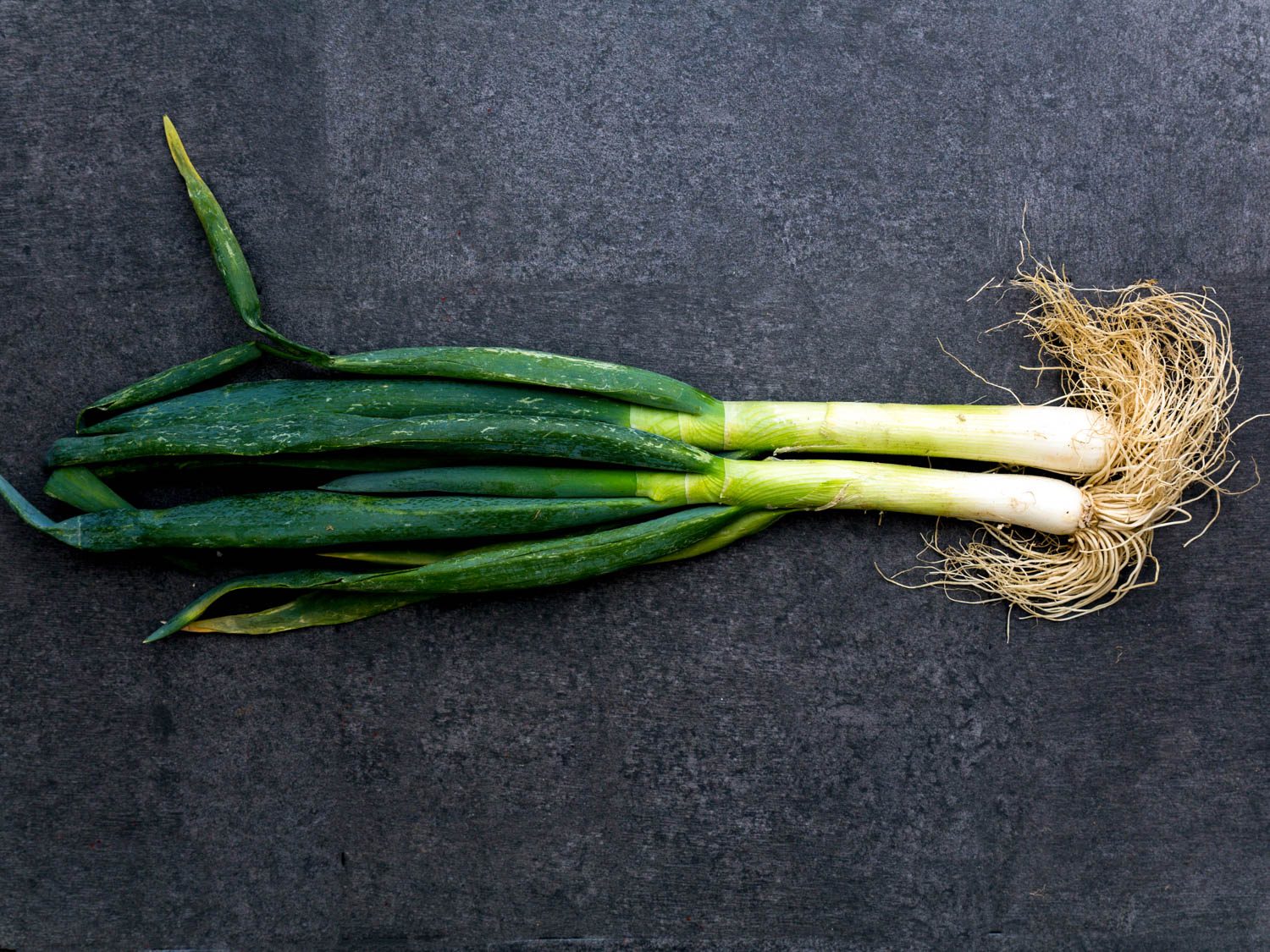
Daepa, or Welsh onion, is basically a giant scallion—“but don’t confuse it with a leek!” laughs Jung. Leeks are tougher and get quite sweet when cooked, she explains, while daepa has more garlicky spice and is typically used alongside garlic. Koreans use the firm white and pale-green base for seasoning, and the floppy, darker-green section for soup stock. “The green part is usually stickier and spicier, while the white part is sweeter,” Jung says. She prefers freshly minced daepa, but says if you want to freeze a bunch, make sure they’re completely dry first to avoid mushiness. You can substitute scallions for daepa in a pinch. This video demonstrates a quick way to mince daepa.
Sesame Seeds
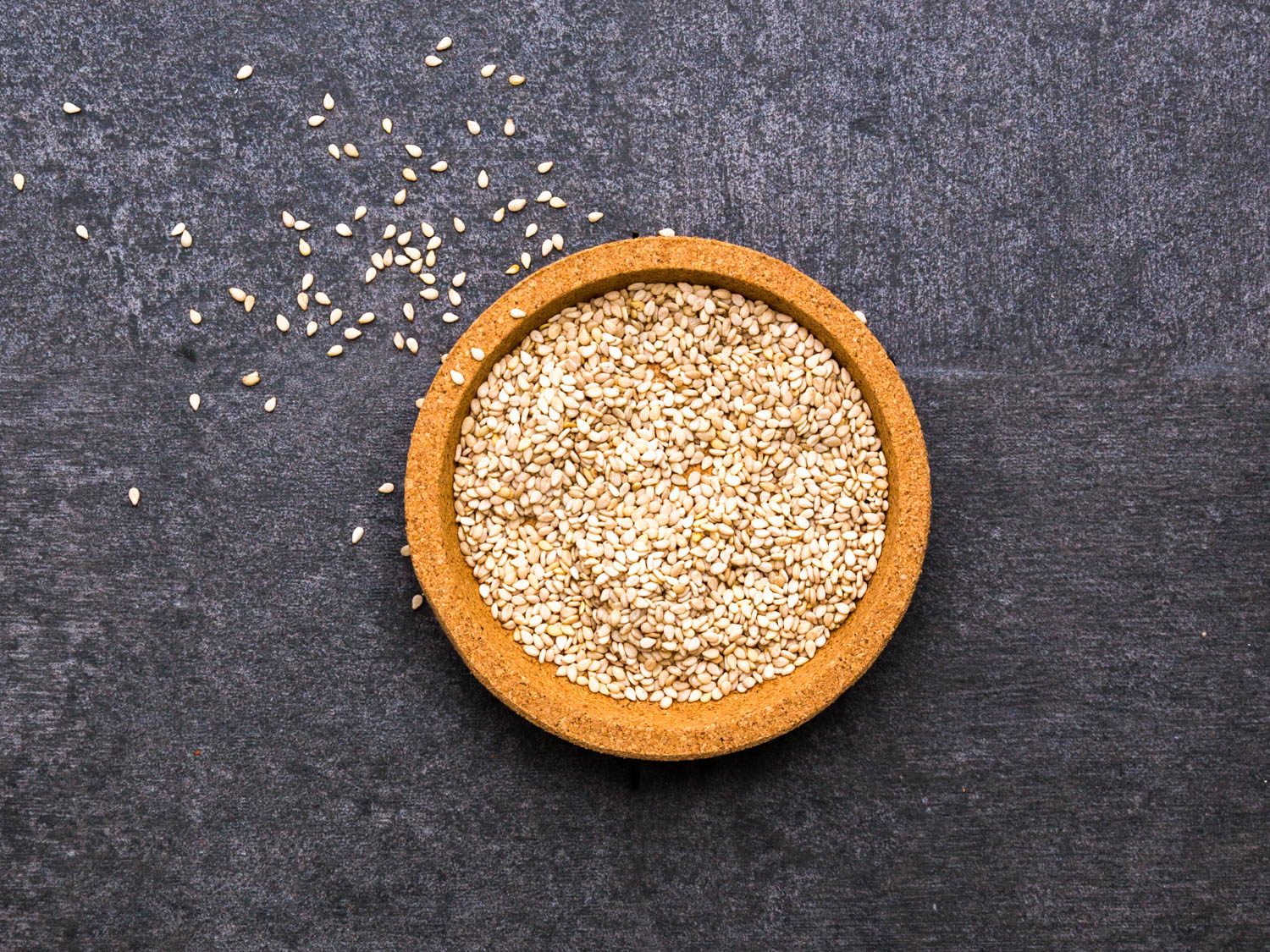
Crushed toasted sesame seeds are called ggaesogeum. Jung buys her sesame seeds whole and untoasted and stores them in the freezer. Later, she toasts small batches at a time, starting by rinsing and draining the seeds. “Rinsing makes a huge difference and keeps the seeds plump,” she says. Gently toast them in a dry pan over medium-low heat “until you start to hear a crackling dadak! dadak! sound.” You should also see the seeds turn a light golden brown, and smell a gently toasted sesame aroma rising from the pan. Jung keeps her roasted sesame seeds in a jar and gently grinds them with a mortar and pestle right before use. (If you’re feeling lazy, you can also crush a spoonful between your palms.)
Plum Syrup
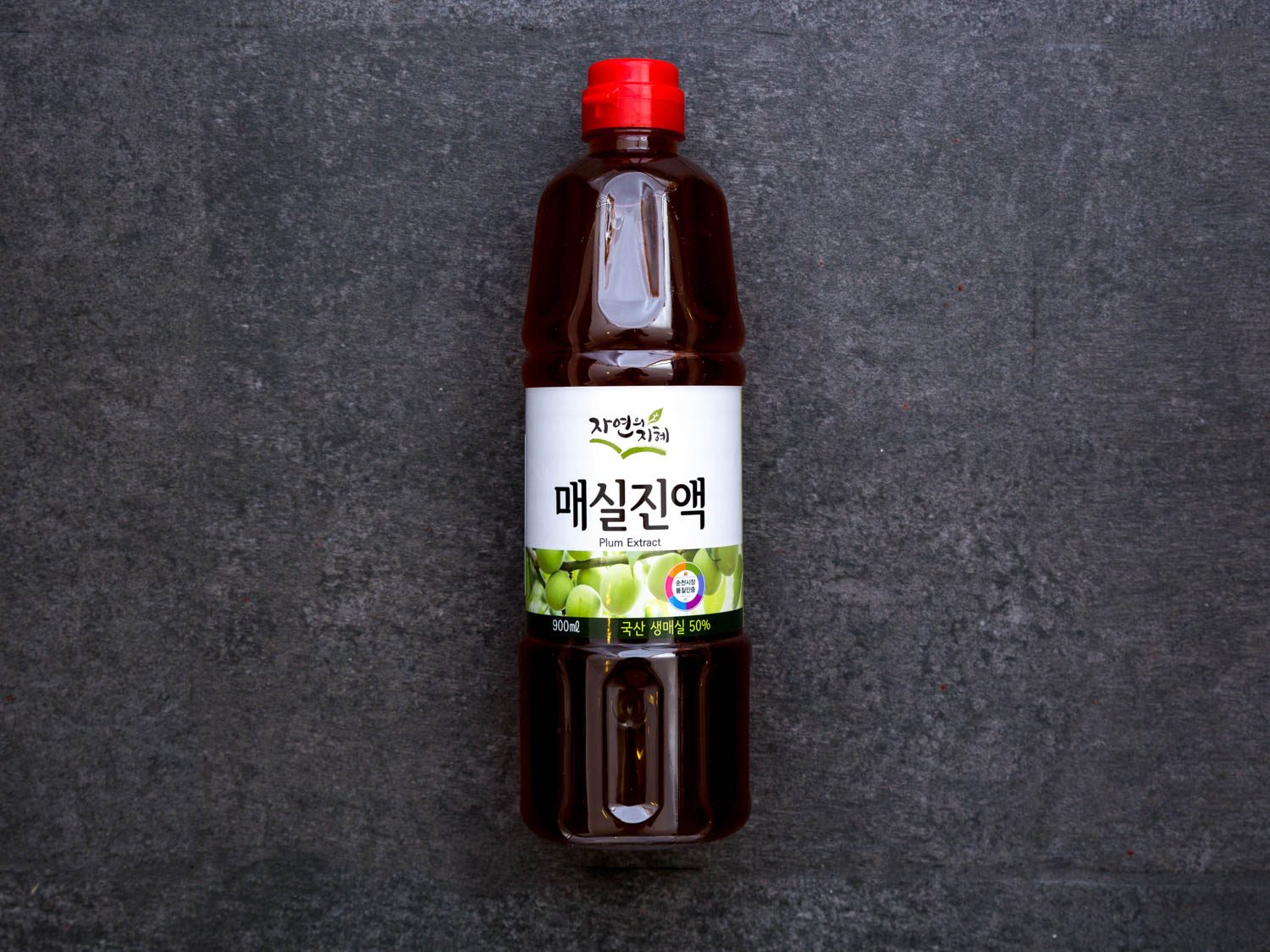
Maesil cheong, or plum syrup, rose in popularity as an alternative to sugar in the last 30 or so years, due in part to the alleged health benefits of green plums aged in sugar. “In any case, maesil adds a really nice touch, similar to finishing with vinegar,” Jung says. “It brightens up your food.”
If you can find green plums in spring, she suggests making your own: Mix equal parts pitted plums and sugar in a jar (or use up to 1.2 parts sugar, if you live in a warm place prone to mold), and let the syrup form naturally over a few months. “Or try making a cheong with fresh cranberries, apples, or onions.”
Sesame Oil
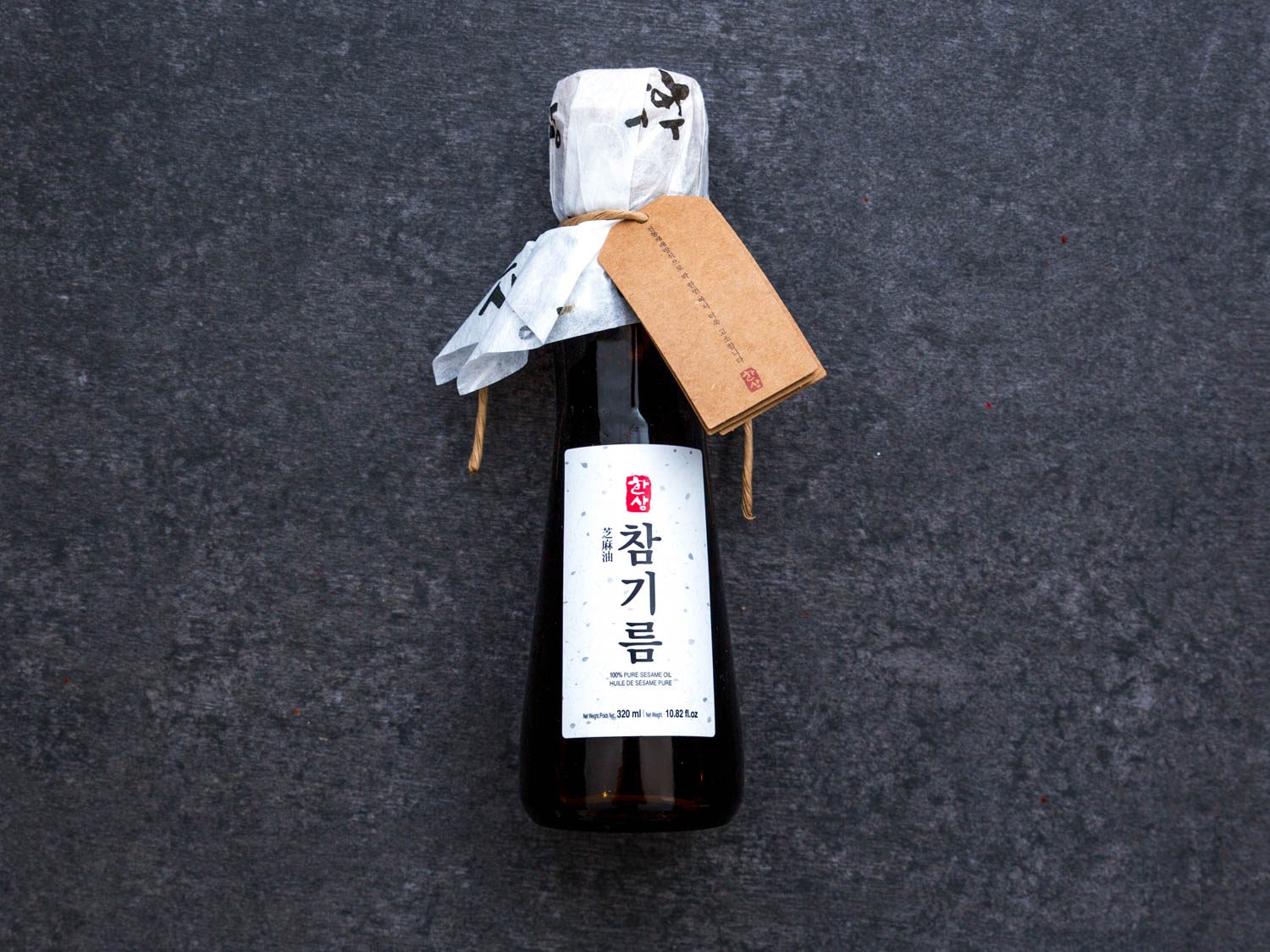
Freshly pressed sesame oil, or chamgireum, has an amazing aroma, but it can be hard to find in the States.* Your next-best option is to look at the sell-by date for the freshest oil available and store it in the fridge after buying. Jung also likes deulgireum, or perilla seed oil, a milder cousin to chamgireum. Since both have low smoke points, she sometimes mixes them with another cooking oil, like grapeseed, when using them for cooking, but says that they’re usually best used as finishing oils. (You can also include them in your everything seasoning.)
* Chong’s Grocery in Los Angeles does sell and ship fresh-pressed sesame oil ($13 for 16 ounces) and perilla oil ($19 for 16 ounces). It’s easiest to have a Korean speaker call and receive the text message with ordering instructions.
Vinegar
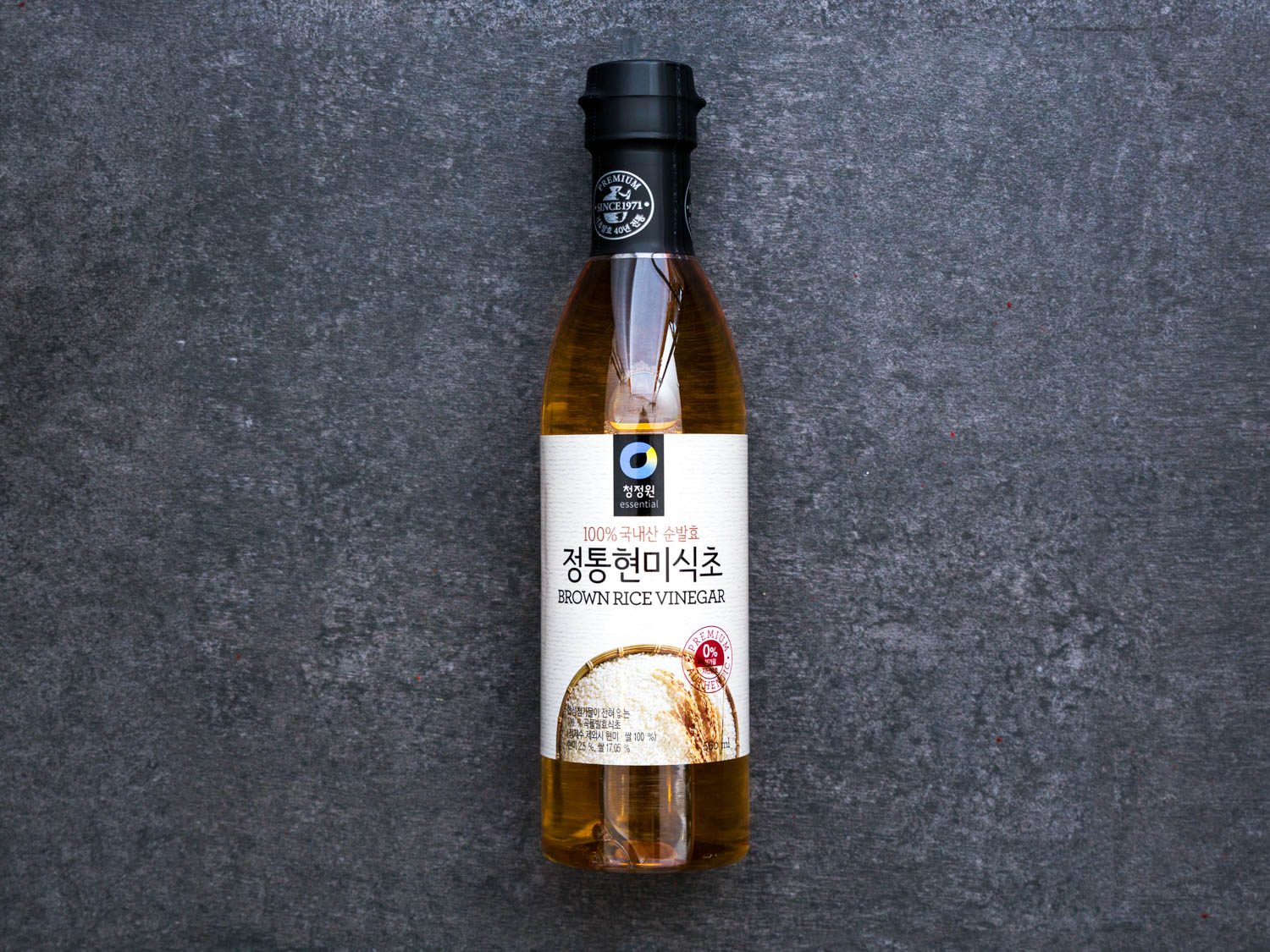
It’s always good to have a little vinegar on hand. Vinegar, says Jung, pairs well with both ganjang and gochujang in banchan seasonings, and cho-gochujang, a vinegared version, is a popular dipping sauce for raw fish and lightly blanched vegetables. She recommends makgeolli shikcho, which is brewed from rice alcohol, but it can be difficult to find in the US; hyunmi shikcho (brown rice vinegar) is a good second choice.
Cooking Alcohol
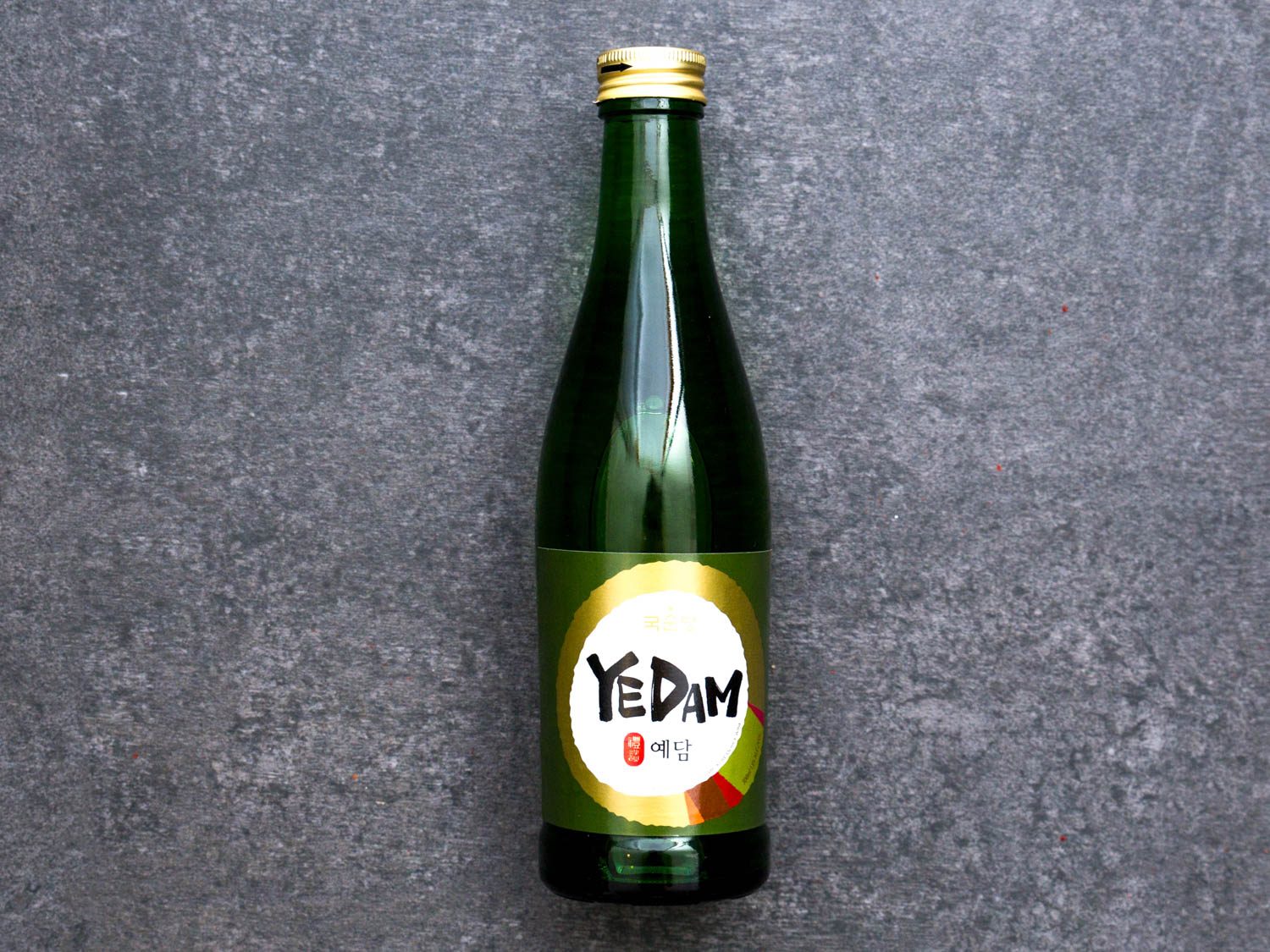
Koreans use cooking alcohol to reduce strong odors from meat and fish. “We are not a fan of blood flavor—for dishes like galbi [grilled short ribs], we even soak the meat overnight in cold water to remove blood!” Jung explains. Her first choice for cooking alcohol is cheongju, a mid-range-ABV brew similar to sake (try Kooksoondang’s Yedam). Absent that, you can substitute soju or even vodka.
Jeot (Salted, Fermented Seafood)
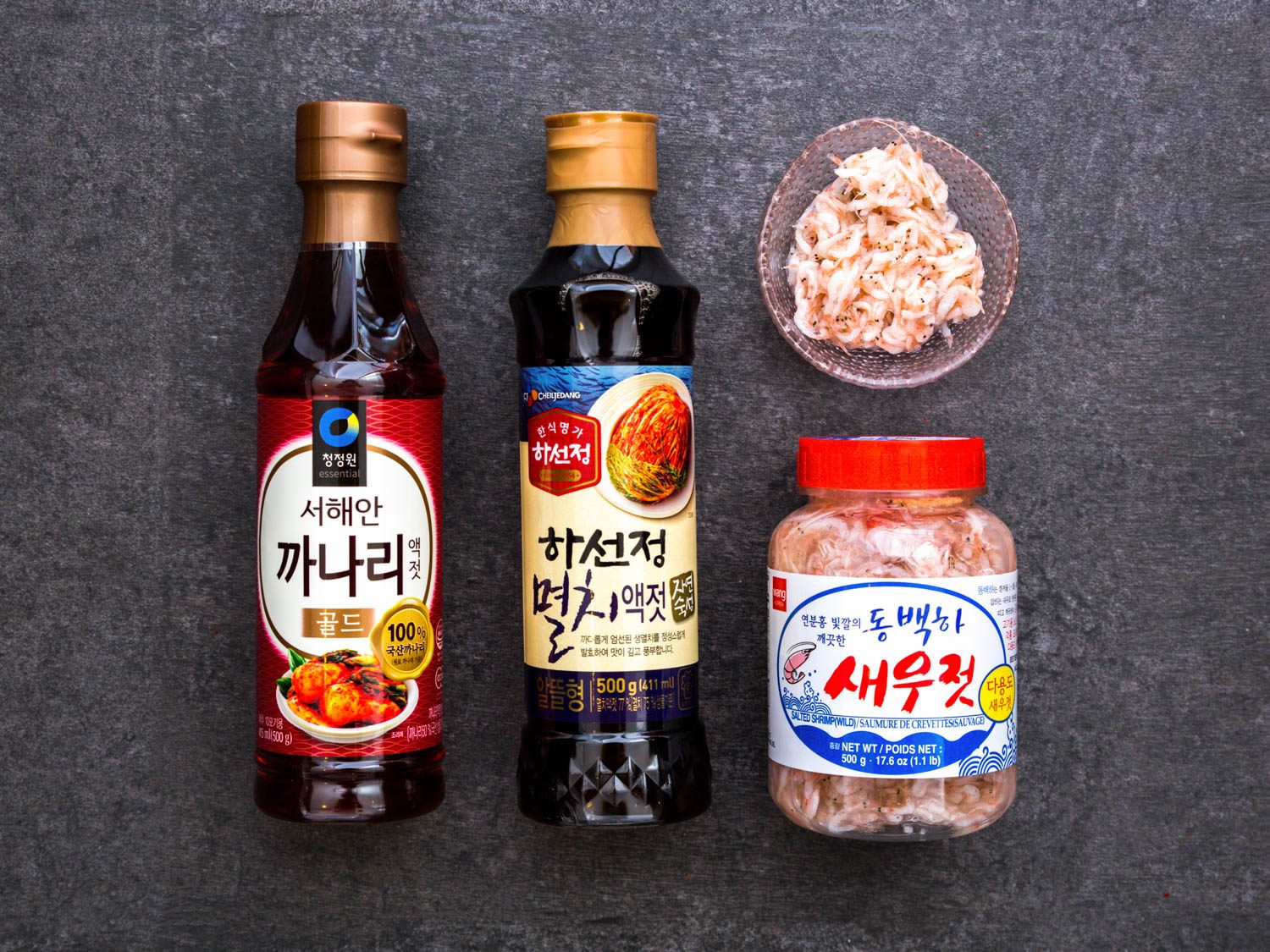
From left to right: sandlance, anchovy, and shrimp jeot.
Jeot, Korea’s salted, fermented seafood condiments, give an extra savory, umami boost to your cooking—and there are over 160 varieties, including salt-cured clams, squid, and fish innards. They’re an essential element in most kimchi recipes, too. “If you use salt, you only get saltiness, but if you use jeot, you get way more depth of flavor,” says Jung. Jeot is sold in both strained, liquid form and paste-like solid form. Two popular types of liquid jeot are myeolchi jeot (anchovy sauce) and gganari aekjeot (sandlance sauce, made from a small fish that burrows into sand). “If you’re a huge fan of fishy flavors, go for the anchovy jeot, which is stronger than sandlance jeot,” Jung advises. Liquid jeot can be mixed with soy sauce or can even replace it entirely, especially in seafood-based soups, like miyeok-guk (seaweed soup), though be warned that the result will be pretty fishy. Korean fish sauce, Jung says, has more sharp and clear flavors than Thai or Vietnamese fish sauce, but you can use those in place of Korean fish sauce if you need to—just be sure to taste as you go along.
If you’re stocking up on jeot, you can’t go wrong with saewoo jeot, fermented shrimp paste. Hundreds of tiny pink shrimp are packed into each jar, which will keep in your fridge for years. “Saewoo jeot is the mildest of the three, and also the sweetest because of the shrimp,” says Jung. If you’re new to fish sauce, she recommends starting with this versatile jeot: Use it in kimchi, steamed egg dishes, and sautéed squash—or even try throwing some into your next pasta sauce. “It’s funky, salty, and sweet all at once.”
Soup Stock Ingredients
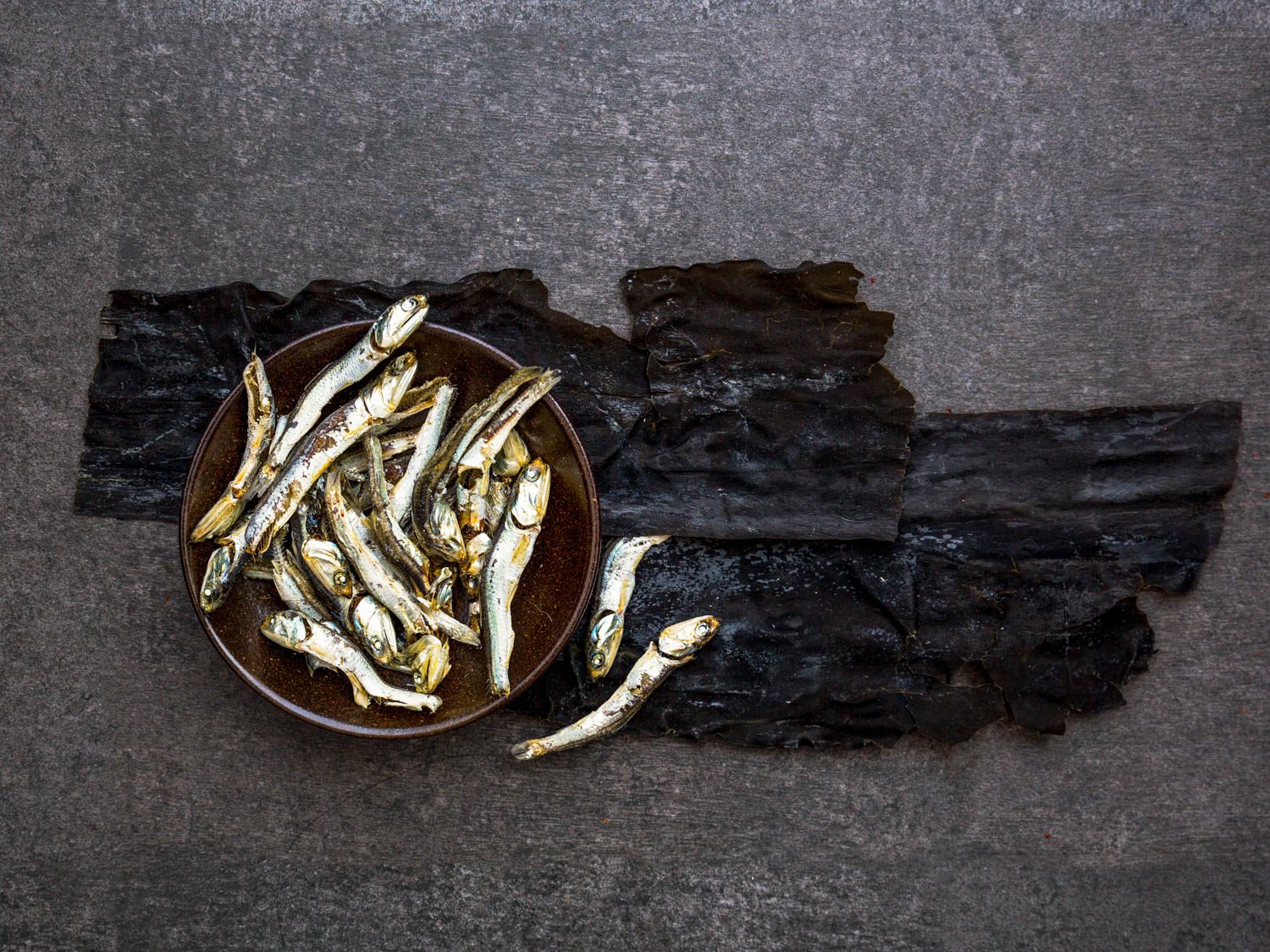
There are all kinds of soup stocks in Korea, but one of the most common is an anchovy-based broth. Simmering these ingredients together is the first step in most soup and stew recipes.
Dried Anchovies
You’ll find a range of dried-anchovy sizes, but for soup stock, Jung recommends going with larger fish, about the size of your little finger or larger (the smaller anchovies are for banchan). Look for plump fish with unbroken, silvery skin. If you’re truly dedicated, pluck out the guts and heads to remove bitter flavors. Here’s a video showing how it’s done.
Dasima
Dasima is also known by its Japanese name, kombu. You can buy this glutamate-rich dried kelp in flat sheets or precut into small squares or long strips. Before using, Jung wipes any residual white powder off with a damp cloth. “It’s all natural, nothing to worry about, but I like to make sure there aren’t any impurities or dust on my dasima,” she explains. Wiping is better, she says, because rinsing your dasima can render it slimy. Jung’s secret dasima tip: “Always make dasima broth with some kind of protein, like anchovies, never just kelp alone,” she says. “The glutamates in the kelp plus the protein molecules give you umami synergy, which really amplifies the umami flavor!”
If you’re feeling ambitious (or if you happen to have any of these odds and ends lying around the kitchen), throw in some dried pyogo (shiitake) mushrooms, white radish, green daepa leaves, dried pollack heads, or onion to add complexity to your stock. But ultimately, Jung says, all you need for a good stock is anchovies and kelp. For the lazy among us, check out her recipe for an easy, make-ahead refrigerator soup stock here.
Source link